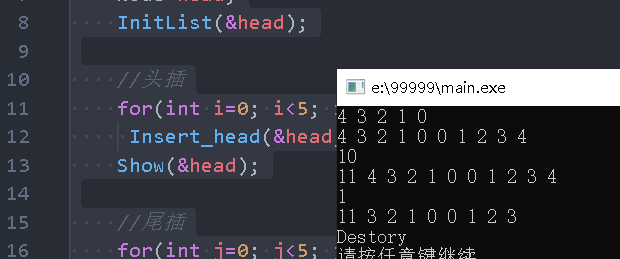数据结构书中代码,未检验
头文件:
#ifndef List_H struct Node; typedef struct Node *PtrToNode; typedef PtrToNode List; typedef PtrToNode Position; List MakeEmpty(List L); int IsEmpty(List L); int IsLast(Position p,List L); Position Find(int x,List L); void Delete(int x,List L); Position FindPrevious(int x,List L); void Insert(int x,List L,Position P); void DeleteList(List L); void show(List L); Position Header(List L); Position First(List L); Position Advance(Position P); #endif
list.cpp(函数接口问题,之前写过)
#include"list.h" #include<bits/stdc++.h> struct Node { int element; Position Next; }; int IsEmpty(List L) { return L->Next == NULL; } int IsLast(Position P,List L) { return P->Next==NULL; } /*返回x在l中的位置,找不到返回NULL */ Position Find(int x,List L) { Position P; P=L->Next; while(P!=NULL&&P->element!=x) P=P->Next; return P; } /*删除x在表中第一次出现*/ /*假如用一次头指针*/ void Delete(int x,List L) { Position P,TmpCell; P=FindPrevious(x,L); if(!IsLast(P,L))//x被找到,删除x; { TmpCell=P->Next; P->Next=TmpCell->Next; free(TmpCell); } } Position FindPrevious(int x,List L) { Position P; P=L; while(P->Next!=NULL && P->Next->element!=x) P=P->Next; return P; } void Insert(int x,List L,Position P) { Position TmpCell; TmpCell=(struct Node *)malloc( sizeof( struct Node) ); TmpCell->element =x; TmpCell->Next=P->Next; P->Next=TmpCell; }
简单的链表实现:
/*头文件*/ #ifndef List_H typedef int Elemtype; typedef struct Node { Elemtype data; struct Node *next; }Node,*List; //初始化单链表 void InitList(List L); //头插法 bool Insert_head(List L,Elemtype x); //尾插法 bool Insert_tail(List L,Elemtype x); //pos位置插入 bool Insert_pos(List L,int pos,Elemtype x); //查找key的前驱 Node *Search(List L,int key); //删除key节点 bool Delete(List L,int key); //是否为空 bool Is_Empty(List L); //摧毁函数 void Destroy(List L); //打印长度 int Getlength(List L); //打印链表 void Show(List L); #endif /*list.cpp*/ #include<stdio.h> #include"list.h" #include<assert.h> //初始化链表 void InitList(List L) { assert(L!=NULL);//assert如果它的条件返回错误,则终止程序执行 L->next=NULL; } //创建新节点 static Node*GetNode(Elemtype x) { Node *PGet=(Node*)malloc(10*sizeof(Node)); assert(PGet!=NULL); PGet->data=x; PGet->next=NULL; return PGet; } //头插法 bool Insert_head(List L,Elemtype x) { assert(L!=NULL); Node *PGet=GetNode(x); PGet->next=L->next; L->next=PGet; return true; } //尾插法 bool Insert_tail(List L,Elemtype x) { assert(L!=NULL); Node *PGet=GetNode(x); Node *P=L->next; while(P->next!=NULL) P=P->next; P->next=PGet; return true; } //pos位置插入 bool Insert_pos(List L,int pos,Elemtype x) { assert(L!=NULL); if(pos<0||pos>Getlength(L)) return false; Node *PGet=GetNode(x); Node *P=L; int i=0; while(i!=pos) P=P->next; PGet->next=P->next; P->next=PGet; return true; } //查找key的前驱 Node*Search(List L,int key) { assert(L!=NULL); if(Is_Empty(L)) return NULL; Node *P=L; while(P->next!=NULL) { if(P->next->data==key) return P; P=P->next; } return NULL; } //删除key节点 bool Delete(List L,int key) { assert(L!=NULL); if(Is_Empty(L)) return false; Node *P=L; while(P->next!=NULL) { if(Search(L,key)!=NULL) { Node *q=Search(L,key); P=q->next; q->next=P->next; P=q; } else P=P->next; } return true; } //是否为空 bool Is_Empty(List L) { if(L->next==NULL) return true; return false; } //摧毁链表 void Destroy(List L) { assert(L!=NULL); Node *p=NULL; while(L->next!=NULL) { p=L->next; L->next=p->next; free(p); } p=NULL; printf("Destory "); } //查找单链表的长度 int Getlength(List L) { int i=0; Node *p=L->next; while(p!=NULL) { p=p->next; i++; } return i; } //打印链表 void Show(List L) { assert(L!=NULL); Node *p=L->next; while(p!=NULL) { printf("%d ",p->data); p=p->next; } printf(" "); } /*main.cpp*/ #include<stdio.h> #include<stdlib.h> #include"list.cpp" int main() { Node head; InitList(&head); //头插 for(int i=0; i<5; i++) Insert_head(&head,i); Show(&head); //尾插 for(int j=0; j<5; j++) { Insert_tail(&head,j); } Show(&head); //打印长度 printf("%d ",Getlength(&head)); //位置插入 Insert_pos(&head,0,11); Show(&head); //key值前驱的数据 printf("%d ",Search(&head,0)->data); //删除某一元素 Delete(&head,4); Show(&head); //删除某一元素 Destroy(&head); system("pause"); return 0; }
